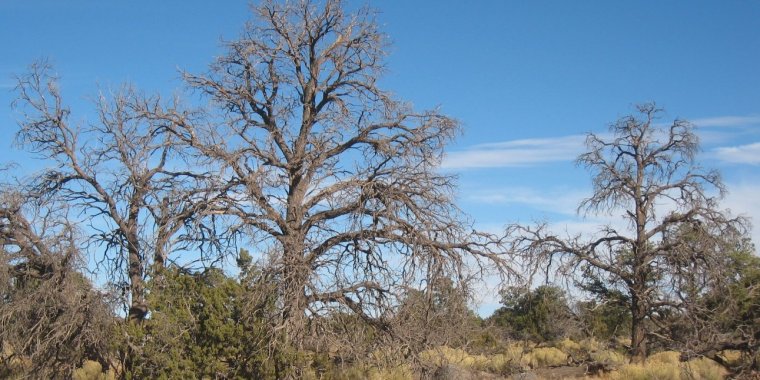| News / Science News |
What's killing trees during droughts?
As the number of droughts increases globally, scientists from Oklahoma State University are working to develop predictions of how future parched conditions will affect plants, especially trees.

Dead pinyon pines near Flagstaff, Arizona, following a severe drought and bark beetle outbreak. ![]()
New results synthesized research from drought manipulation studies and revealed the mechanisms by which tree deaths happen.
How trees respond to drought is important for models used to predict climate change. Plants take up a large portion of the carbon dioxide (CO2) in the atmosphere -- fewer trees means more CO2.
Sudden large-scale changes in plant populations, such as the tree die-offs observed worldwide in recent decades, could affect the rate at which climate changes.
Current global vegetation models have faced challenges in producing consistent estimates of plant CO2 uptake, scientists say. The predictions vary widely depending on assumptions about how plants respond to climate.
One idea for improving the models is to base forest responses to climate change on how trees die in response to heat, drought and other stresses. But progress has been limited by disagreement over a central question: What, exactly, causes tree deaths?
In some cases, the deaths are a result of carbon starvation, in which trees close their pores, essentially starving themselves by blocking the entry of carbon, which is needed for photosynthesis. Or the culprit is hydraulic failure: the inability of a plant to move water from roots to leaves.
99 percent of the water moving through a tree is used to keep stomata open. Stomata are the pores that let in carbon dioxide, allowing a tree to carry out photosynthesis.
Trees respond to the stress of drought by closing these pores. They then need to rely on stored sugars and starches to stay alive, and will die if these run out before a drought ends.
If a tree loses too much water too quickly, an air bubble (embolism) forms. The tree then has hydraulic failure and cannot transport water from the roots to the leaves, causing it to dry out and die.
The scientists found that hydraulic failure is universal when trees die, while carbon starvation is a contributing factor roughly half the time. (National Science Foundation)
YOU MAY ALSO LIKE




